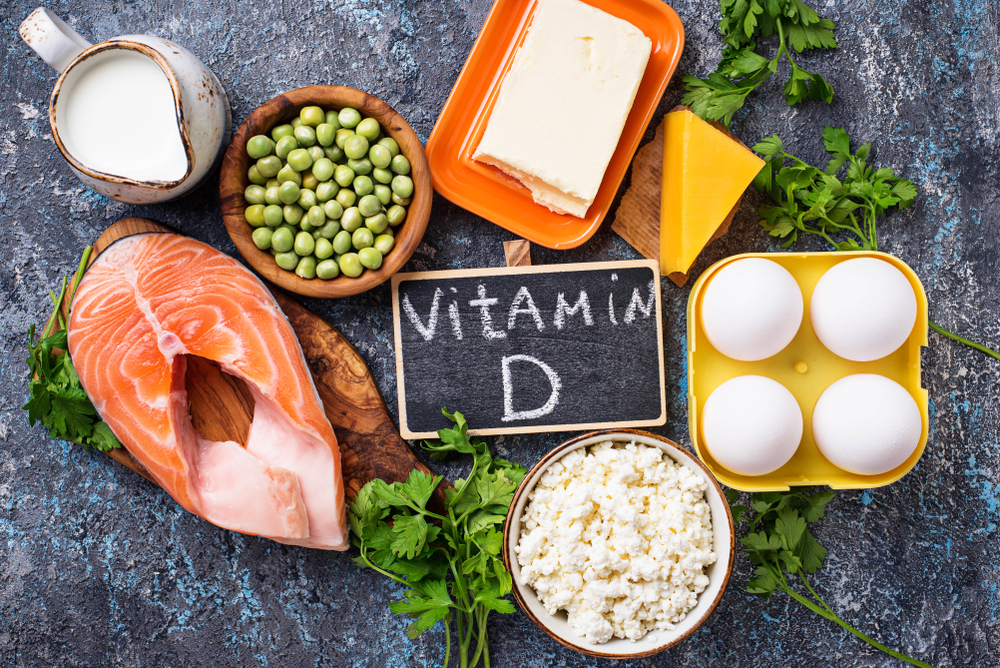Why do you need adequate amounts of vitamin D? The most obvious reason is bone health. Vitamin D helps your body absorb enough calcium to build strong, healthy bones. Vitamin D also plays a role in the immune system and muscle function. Research suggests that an adequate amount of this vitamin supports cognitive function and increased insulin sensitivity.
How can you maintain a healthy level? If you live in a northern region of the US, it’s difficult to get enough vitamin D through diet alone. In fact, studies show that up to 70% of people living in these regions don’t get enough vitamin D through sunlight and food for optimal health. That’s because Northern latitudes get less direct sunlight. To make vitamin D, UVB (ultraviolet B rays) must activate a compound on your skin called dehydrocholesterol. Upon activation, your liver and kidneys chemically change dehydrocholesterol to build activate vitamin D.
Seasonal Changes in Vitamin D Level
Some people can get enough sunlight to produce an adequate amount of vitamin D during the summer months. Although your body stores vitamin D, not everyone can maintain an adequate vitamin D level from one sunny season to the next and levels may drop in the winter. For example, if you live in Alaska and expose your skin to strong sunlight during the summer months, you may not get enough vitamin D from sunlight alone during the winter months. This is because the duration of sunlight exposure is shorter and there’s less UV radiation from sunlight during the winter months.
In the spring and fall, the situation can still be troublesome. There’s not enough sunlight during these seasons to make vitamin D levels rise to their maximum peak in the summer. And in most cases, people spend their days indoors working indoors behind glass and windows block the UVB light you need to synthesize vitamin D. Even if you spend time outdoors, wearing sunscreen will reduce the amount of vitamin D your body makes.
The lack of sun exposure due to season, latitude, or an indoor job is why so many people need a vitamin D supplement. While it’s possible to get enough from sunlight alone, if you work outdoors or live in a sunny area throughout the year, there are advantages to taking a supplement too. Let’s take a closer look at vitamin D supplements.
What You Should Know About Taking a Vitamin D Supplement
There are two types of supplemental vitamin D: ergocalciferol (D2) and cholecalciferol (D3). Ergocalciferol, also known as “vitamin D2,” is made from fungi or yeast extracts and there’s some question as to its potency, whether it’s as potent as vitamin D3. Some research shows ergocalciferol may also be less effective at regulating blood calcium levels. In general, vitamin D2 is most commonly used to treat rickets in infants and children. Cholecalciferol, or “vitamin D3,” is the preferred form of supplemental vitamin D for maintaining blood calcium levels and protecting the bones from fractures.
Vitamin D3 is only in animal-based sources of vitamin D, such as fatty fish whereas vitamin D2 is from plant-based sources, such as mushrooms exposed to ultraviolet light. Foods fortified with vitamin D usually contain vitamin D2 since it’s less expensive.
Testing for Vitamin D
What is a healthy vitamin D level? A blood test called a 25(OH)D test is the most reliable way to diagnose vitamin D deficiency, but it’s more expensive. The most common 25(OH)D test involves taking a blood sample and putting it into a machine that measures the levels of different hormones in the blood. The levels of these hormones then help determine your vitamin D status. These are what the values mean based on the National Institutes of Health:
- deficiency: less than 30 nmol/L (12 ng/mL)
- borderline deficiency: between 30 nmol/L (12 ng/mL) and 50 nmol/L (20 ng/mL)
- normal: between 50 nmol/L (20 ng/mL) and 125 nmol/L (50 ng/mL)
- high levels: greater than 125 nmol/L (50 ng/mL)
Vitamin D Supplements
No matter which type of vitamin D you decide to take, it’s important to get your dosage right. The NIH recommends 600 IU daily for adults under the age of 70 and 800 IU over that age. However, many experts believe these recommendations are too low, especially for younger people, and that’s an area that needs more research. Vitamin D supplements are usually measured by a unit called an “international unit” or IU and is equal to 0.025 micrograms of vitamin D3. Each country has its own unit measurements.
It’s important to note that the vitamin D dosage needs to be individualized, which means you should work with a doctor or nutritionist that can help you determine the dosage right for you. The best way to do this is by checking your vitamin D and calcium levels. If your doctor or nutritionist changes your dosage, then you should redo the tests after three months.
What about Food Sources of Vitamin D?
A lot of food sources that we think of as being vitamin D rich don’t actually have very much vitamin D. For example, 3.5 ounces of tuna has only about 268 IU of vitamin D and a serving of farmed salmon has around 250 IU. While it’s still important to eat these foods, they won’t give you the amount you need for optimal health, especially if you are deficient in vitamin D. Fortified foods contain varying amounts of vitamin D, so it’s important to read the label and determine how much vitamin D is in each serving.
The only way to meet your daily needs to make sure you are getting adequate amounts of vitamin D is by eating foods such as some fish, eggs, or supplements that contain a high-fat content. Fat increases how much vitamin D your body absorbs. Natural sources of vitamin D include cod liver oil, fatty fish, egg yolks, and mushrooms exposed to ultraviolet light. As mentioned, manufacturers fortify some foods with varying amounts of vitamin D. However, it’s difficult to get enough vitamin D to maintain a healthy level through diet alone.
Certain People Are at Higher Risk of Vitamin D Deficiency
If you have a darker skin color, you’ll need to spend more time in the sun to maintain a healthy vitamin D level. Darker skin has more melanin and melanin reduces vitamin D synthesis. People who are older or who are obese are also at greater risk of falling low in vitamin D. Certain health conditions make vitamin D deficiency more likely. If you have liver or kidney problems, you may have trouble producing enough active vitamin D since these two organs activate the vitamin D precursor your skin creates.
The Bottom Line
Know what your risk factors are for vitamin D deficiency. If you’re at high risk, check your vitamin D level regularly and talk to a physician or nutritionist to make sure you’re getting enough vitamin D for optimal health.



